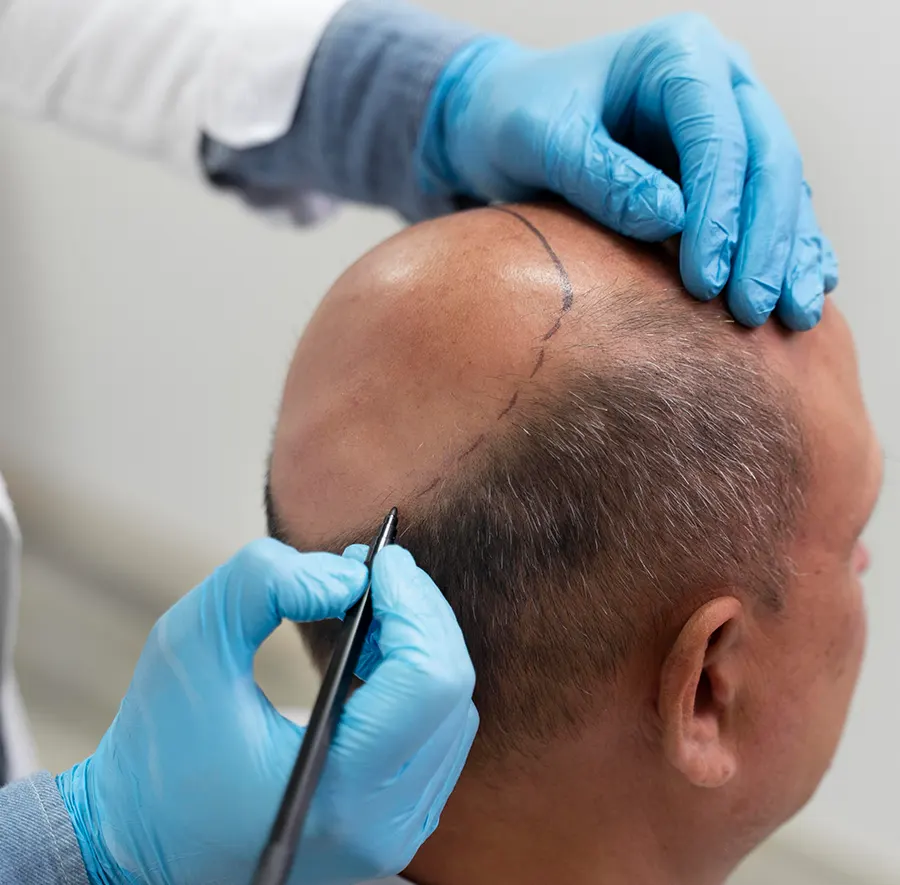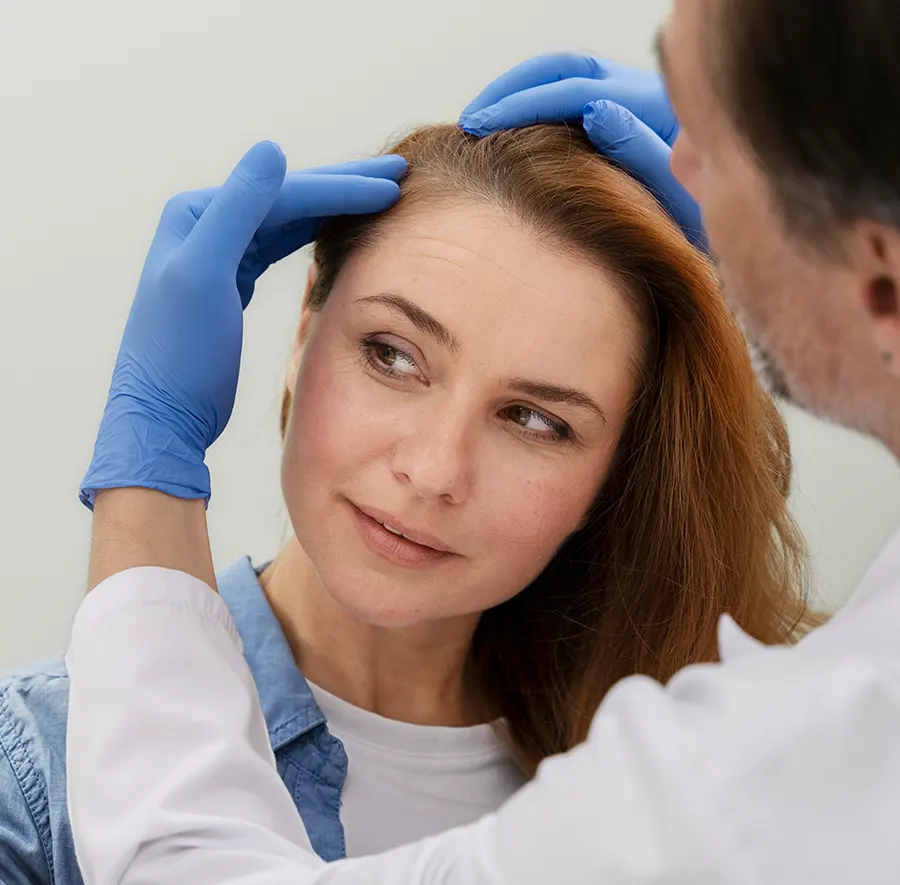Share on socials:
Receding hairline stages: Understand your AGA grade
A Complete Guide by Kera Hair Clinic
Hair loss can be alarming, especially when it begins with a receding hairline. While it’s common to notice a few extra strands in the shower or on your pillow, progressive thinning at the temples and forehead might indicate something more serious — androgenetic alopecia (AGA), also known as male or female pattern baldness.
This comprehensive blog helps you decode the stages of a receding hairline through the AGA grading system. Our aim is to help you understand your hair loss pattern early and make informed choices about your treatment.

What Is AGA (Androgenetic Alopecia)?
Androgenetic Alopecia is a genetic condition that causes progressive hair thinning and baldness. It affects both men and women, though the patterns differ. AGA is the most common cause of hair loss worldwide.
In men: It usually begins with a receding hairline or thinning crown.
In women: Diffuse thinning across the scalp, especially the crown.
Early detection and proper classification are key to managing AGA effectively.
The Norwood-Hamilton Scale: Stages of Male Pattern Baldness
For men, the Norwood-Hamilton scale is widely used to grade the severity of hair loss.
Stage 1
- Minimal or no recession of the hairline.
- Hair appears full and healthy.
Stage 2
- Slight recession at the temples.
- Early signs of a mature hairline.
Stage 3
- Deep, noticeable recession forming an M-shaped hairline.
- Considered the earliest stage of significant hair loss.
Stage 3 Vertex
- Recession at the temples and noticeable thinning at the crown (vertex).
Stage 4
- Hairline recedes further; the bald spot on the crown enlarges.
- A bridge of hair still separates the frontal and crown balding areas.
Stage 5
- Bridge of hair becomes narrower.
- Bald areas expand.
Stage 6
- Bridge disappears; the top of the scalp is largely bald.
Stage 7
- Most severe form.
- Only a horseshoe-shaped rim of hair remains on the sides and back.
KERA uses detailed diagnostic tools, including trichoscopy and digital scalp analysis, to determine your Norwood grade and suggest a personalised treatment plan.
The Ludwig Scale: Stages of Female Pattern Hair Loss
In women, hair loss due to AGA is assessed using the Ludwig Scale.
Stage I
- Thinning at the crown with preserved frontal hairline.
Stage II
- Increased thinning and widening of the central part.
Stage III
- Severe diffuse thinning across the top.
Kera offers hormone analysis and nutritional screening in women to identify the root cause and customise therapy.
Common Signs of a Receding Hairline
- Noticeable forehead widening
- More hair fall around temples
- Difficulty styling hair the usual way
- Miniaturisation (thinner, finer hair strands)
- Itchy or flaky scalp in some cases
Early intervention can prevent progression and improve outcomes.
What Causes AGA?
- Genetics (family history of hair loss)
- Hormonal imbalances (especially DHT sensitivity)
- Ageing
- Nutritional deficiencies
- Stress
- Smoking and lifestyle factors
How Kera Hair Clinic Helps You Understand and Manage AGA
At Kera Hair Clinic, we combine experience with cutting-edge technology to assess and manage all stages of hair loss. Here’s how we help:
1. Detailed Hair Loss Evaluation
- Digital scalp scanning
- DHT sensitivity testing
- Blood tests for iron, thyroid, vitamin levels
2. Non-Surgical Treatments
- PRP Therapy: Platelet-rich plasma injections to stimulate growth.
- Exosome Therapy: A newer, advanced regenerative method.
- Medications: FDA-approved options like Finasteride and Minoxidil.
3. Surgical Options
- Hair Transplant: FUE and FUT techniques performed with precision.
- Hair Transplant: FUE and FUT techniques performed with precision.
4. Maintenance and Aftercare
- Kera offers post-treatment support with hair growth boosters, supplements, and custom care plans.
Why Early Diagnosis Matters
Understanding your AGA grade helps you:
- Choose the right treatment at the right time
- Prevent irreversible damage to hair follicles
- Save on future costs
- Improve success rates of medical or surgical solutions
Real Stories, Real Results
Many patients at Kera have experienced full or partial restoration after timely diagnosis and personalized care. From college students facing early-stage hairline recession to older clients considering transplants — we’ve seen lives transformed.

Conclusion
A receding hairline is not just a cosmetic concern — it can be the first indicator of progressive hair loss. Recognising your AGA grade early allows for better treatment outcomes and restored confidence.
KERA is your trusted partner in diagnosing, treating, and maintaining healthy hair at every stage. With advanced diagnostics, experienced trichologists, and a commitment to holistic care, we ensure your hair loss journey is handled with expertise and empathy.
Take the First Step Today!
Don’t let hair loss define you. Whether you’re looking to restore your hairline, achieve fuller density, or regain confidence, KERA is here to help. Our expert team is dedicated to providing cutting-edge hair restoration solutions tailored to your needs.
For Those Inspired by Our Mission, Here’s How You Can Stay Connected and Support Us
Follow us on Instagram (@keratrichology) to stay updated on the latest advancements in hair restoration, success stories, and expert tips. Help us spread awareness about the importance of early intervention and advanced treatments like DHI and PRP therapy.
By sharing your journey and educating others, you contribute to breaking the stigma around hair loss and encouraging people to take action. Let’s work together to inspire confidence and redefine hair restoration—one transformation at a time!
